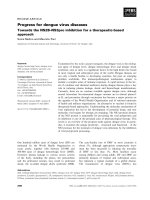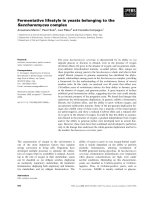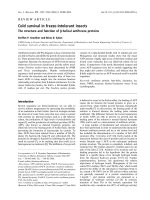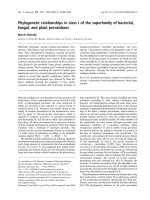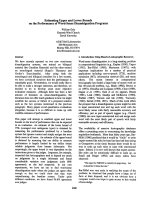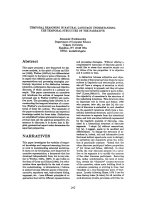Báo cáo khoa học: "Myocardial injury in infants ventilated on the paediatric intensive care unit: a case control study" pot
Bạn đang xem bản rút gọn của tài liệu. Xem và tải ngay bản đầy đủ của tài liệu tại đây (158.64 KB, 6 trang )
Open Access
Available online />Page 1 of 6
(page number not for citation purposes)
Vol 10 No 5
Research
Myocardial injury in infants ventilated on the paediatric intensive
care unit: a case control study
Simon J Clark, Michael Eisenhut, Dorothea Sidaras, Stephen W Hancock, Paul Newland and
Kent Thorburn
Royal Liverpool Children's NHS Trust, Eaton Road, Liverpool L12 2AP, UK
Corresponding author: Michael Eisenhut,
Received: 11 Jul 2006 Revisions requested: 16 Aug 2006 Revisions received: 18 Aug 2006 Accepted: 11 Sep 2006 Published: 11 Sep 2006
Critical Care 2006, 10:R128 (doi:10.1186/cc5040)
This article is online at: />© 2006 Clark et al.; licensee BioMed Central Ltd.
This is an open access article distributed under the terms of the Creative Commons Attribution License ( />),
which permits unrestricted use, distribution, and reproduction in any medium, provided the original work is properly cited.
Abstract
Introduction Cardiac troponin T (cTnT) has been used to
assess prevalence of myocardial injury in critically ill children.
The majority of studies investigated patients undergoing cardiac
surgery. Myocardial injury has been associated with increased
mortality. Our objectives were to investigate whether cTnT levels
are elevated in infants without congenital heart disease admitted
to the paediatric intensive care unit (PICU) and whether levels
are associated with increased disease severity.
Methods We measured cTnT in consecutive infants (<12
months old) without congenital heart disease admitted to the
PICU and healthy infants. The Paediatric Index of Mortality (PIM)
score was determined in patients on the PICU.
Results We recruited 107 infants: 47 infants admitted to the
PICU and 60 healthy controls. Controls were, with a median
(interquartile range (IQR)) age of 20 (12 to 34) weeks,
significantly older than cases, with a median age of 6.5 (0.3 to
20.6) weeks. CTnT levels were, with a median (IQR) of 18 (10
to 60) pg/ml, significantly higher in admissions to the PICU than
in controls, with a median level of 10 (10 to 10) pg/ml (95th
centile of 20 pg/ml) (p < 0.001). There was a significant positive
correlation (r = 0.41, p = 0.004) between PIM score and cTnT
levels. Admissions under one month old had higher cTnT levels
than older patients (p = 0.013) but the PIM score was not
significantly different between them. When corrected for age
and weight the correlation of PIM and cTnT was no longer
significant.
Conclusion Infants on the PICU in the neonatal period have
higher cTnT levels compared to older infants despite not having
more severe disease.
Introduction
Troponin is an inhibitory protein complex forming part of the
contractile apparatus of all striated muscle, including the heart.
Specific forms of the troponin subunits T, C and I exist in dif-
ferent muscle types. Cardiac specific troponins T and I have
become established as the gold standard biochemical mark-
ers for myocardial necrosis [1,2]. The third generation assays
for cardiac troponin T (cTnT) are now so sensitive and specific
that a concept of minimal myocardial damage has arisen [1].
These marginal elevations of cTnT are associated with
increased hospital morbidity and mortality in adult patients fol-
lowing admission [3,4].
There are now increasing numbers of reports of troponin being
measured in children as a marker for myocardial injury and dis-
ease severity. In healthy older children and neonates (in cord
blood) cardiac troponins are undetectable [5,6]. Elevated car-
diac troponin levels have been detected in children critically ill
with congenital heart disease before and after cardiac surgery
[5,7]. In patients without congenital heart disease raised car-
diac troponin levels have been found in paediatric intensive
care admissions with severe respiratory syncytial virus infec-
tion [8] and with meningococcal and other forms of septicemia
[9-12]. In meningococcal septicemia cardiac troponin levels
have been associated with increased disease severity and car-
diac dysfunction [9].
We tested the hypotheses that in critically ill infants without
congenital heart disease there is evidence of myocardial injury
and that cTnT levels are associated with disease severity.
BP = blood pressure; cTnT = cardiac troponin T; PICU = paediatric intensive care unit; PIM = Paediatric Index of Mortality.
Critical Care Vol 10 No 5 Clark et al.
Page 2 of 6
(page number not for citation purposes)
Materials and methods
Patients
We measured cTnT in two groups of infants (less than one
year old). The first group comprised critically ill infants admit-
ted to a tertiary paediatric intensive care unit (PICU) at the
Royal Liverpool Children's Hospital for ventilatory support.
From this group we collected two samples, one on admission
and another 24 hours later. All blood sampling was performed
at the time of routine phlebotomy or arterial line sampling. We
excluded patients admitted for routine cardiac surgery or with
a primary cardiac diagnosis.
The second group was a control group of healthy infants hav-
ing elective invasive procedures, who had one sample taken at
the time of routine outpatient phlebotomy, or during day case,
or short stay uncomplicated surgery when venous accessed
was established. Children with known cardiac abnormalities
were excluded from this group.
The local research ethics committee approved the study pro-
tocol and valid written parental consent was obtained.
Data collection
Demographic data were recorded, including the age of the
patient on admission, diagnosis and pre-existing illnesses, the
Paediatric Index of Mortality (PIM) score [13], ventilation set-
tings, blood gases, requirements for fluid boluses, inotrope
infusions, and outcome.
Sample collection and analysis
Samples were centrifuged, separated and frozen at -20°C until
batch analysis was performed. We performed biochemical
analysis with an Elecsys 1010 System analyser using the Elec-
sys Troponin T STAT Immunoassay (Roche Diagnostics
GmbH, Mannheim, Germany). This electrochemiluminescent
sandwich enzyme linked immunosorbant assay has a lower
limit of detection of 10 pg/ml, with minimal cross reactivity with
cardiac troponin I of 0.002%, and skeletal troponin T of
0.001% [14]. The coefficient of variation for paired samples
was less than 10% across the assay range. The coefficient of
variation for the internal quality control was less than 6.4% at
two concentrations (100 pg/ml and 5,400 pg/ml).
Data analysis
cTnT is not normally distributed. Therefore, non-parametric
tests were used for this parameter and other continuous data
as appropriate; these included Mann-Whitney U test, Wil-
coxon signed rank test and Spearman's rank correlation coef-
ficient. Chi-square and Fisher's exact test were used for
comparison of categorical data as appropriate. Correction for
age and weight was performed using partial correlation coeffi-
cients and by subgroup analysis. We performed subgroup
analysis to compare those admissions under one month old
with those over one month old. A p value of less than 0.05 was
taken as an indicator of a statistically significant difference.
Analysis was performed using Arcus BioStat (Biostat Inc.,
Englewood, NJ, USA) and SPSS (SPSS Inc., Chicago, IL,
USA) release 13.0. Undetectable levels of cTnT were
assigned the value of the lower limit of the assay, 10 pg/ml.
Results
Healthy Infants
Sixty healthy infants were recruited into the study. The cTnT
levels had a median (interquartile range) of 10 (10 to 10) pg/
ml with a 95th percentile of 20 pg/ml (maximum: 100 pg/ml).
Their median age was 20 (12 to 34) weeks, with 48 (77%) of
the samples being collected under general anaesthetic. cTnT
was detected in six (10%) of the healthy infants. Diagnoses in
these six patients were (one patient each): inguinal hernia; skin
tag; haemangioma; hypothyroidism; phenylketonuria; and
haemolytic anaemia. There was no statistically significant dif-
ference between the values from surgical patients or from
medical patients within this group. Table 1 shows the list of
diagnoses in healthy infants.
Paediatric intensive care admissions
We included 47 PICU patients who were all intubated and
ventilated in our study. We obtained 47 admission samples,
which had cTnT levels with a median of 18 (10 to 60) pg/ml.
This was statistically significantly higher that the levels of the
healthy infants (p < 0.001). There was a statistically significant
correlation between the PIM score and cTnT (r = 0.41, p =
0.004). This relationship was no longer significant once age
and weight were corrected for (r = 0.025, p = 0.95). The dura-
tion of mechanical ventilation was not different between
Figure 1
Box and whisker plots for cardiac troponin T values in neonatal and older intensive care admissions along with healthy infantsBox and whisker plots for cardiac troponin T values in neonatal and
older intensive care admissions along with healthy infants. The boxes
are the interquartile ranges, the whiskers are the 5th to 95th percen-
tiles, with the heavy black line representing the median. *p = 0.006
compared with healthy infants; **p = 0.013 compared with older inten-
sive care admissions; ***p < 0.001 compared with healthy infants.
Available online />Page 3 of 6
(page number not for citation purposes)
patients with and without elevated cTnT levels, with a median
of 3.0 days in both groups (p = 0.66).
Of the 47 admissions to paediatric intensive care, 22 were
infants less than one month old (neonates) and they had sta-
tistically significantly higher cTnT levels when compared with
the older infants admitted for paediatric intensive care (median
38 (19 to 95) pg/ml versus 10 (10 to 30) pg/ml, p = 0.013;
Figure 1). There was no correlation between the PIM score
and the cTnT levels in the neonates (r = 0.27, p = 0.22). In the
25 older paediatric intensive care admissions, the correlation
between the PIM score and cTnT remained significant (r =
0.44, p = 0.028). However, there was no statistically signifi-
cant difference between the PIM scores for neonates and
older infants on the PICU. One infant in each group required
inotropes.
In the neonates on the PICU cTnT levels for only 5/22 were
undetectable compared with 17/25 undetectable results in
the 25 older infants (p = 0.003 using Fisher's exact test). The
older paediatric intensive care admissions' levels of cTnT were
statistically significantly higher than the control population (p =
0.006; Figure 1).
Table 2 gives demographic details for these two subgroups.
There was an excess of surgical patients among the neonates
(17/22 versus 6/25, p < 0.001 with Fisher's exact test). Table
3 gives the list of diagnoses for both groups. We included a
total of seven patients with sepsis, one neonate and six older
infants. Elevated cardiac troponin levels were found in two of
these seven infants. There were two deaths; one from menin-
gitis and one from secondary pneumonia following respiratory
syncytial virus infection and both patients had undetectable
cTnT on admission.
Paired samples
As the samples were measured secondary to clinical analysis
there was resulting attrition arising from small volume collec-
tion and/or second samples not being collected and only 35
paired samples were obtained. There were no changes in the
16 paired samples from admissions under one month old
(median 47 (11 to 84) pg/ml on admission and 43 (10 to 92)
pg/ml 24 hours later). There were also no changes in the levels
from the 19 paired samples in older infants (median 10 (10 to
28) pg/ml on admission and 10 (10 to 10) pg/ml 24 hours
later). The neonatal levels were statistically significantly higher
on admission and 24 hours later (p = 0.049 and p = 0.007,
respectively) compared with the older infants admissions'
levels.
Discussion
Admissions to paediatric intensive care had significantly
raised cTnT levels compared to controls and this elevation per-
sisted for at least 24 hours. There was a significant correlation
between the cTnT levels and the disease severity score, but
this did not persist when age and weight were corrected for.
Neonates admitted to paediatric intensive care had signifi-
cantly higher cTnT levels compared with the older intensive
care admissions, but despite this there was no statistically sig-
nificant difference in the critical illness score between these
two subgroups.
Table 1
Diagnoses in 60 healthy infants
No. of infants (percent)
Male 36 (60)
Age in weeks (median, IQR) 20 (12 to 34)
Orthopaedic procedures 6 (10)
Neurosurgical procedures 2 (3)
Circumcisions 5 (8)
Magnetic resonance scan under anaesthetic 1 (2)
Cleft lip repairs 5 (8)
Inguinal hernia repairs 8 (13)
Other abdominal operations 7 (12)
Plastic/laser surgery 6 (10)
Pyeloplasty 1 (2)
Plastic/laser surgery 6 (10)
Cataracts 1 (2)
Medical patients 12 (20)
IQR, interquartile range.
Critical Care Vol 10 No 5 Clark et al.
Page 4 of 6
(page number not for citation purposes)
Neonates on PICU
In neonates elevation of cTnT may relate to perinatal stress
factors [5]. Minor elevations of around 25 pg/ml are seen more
commonly between 48 and 96 hours after delivery [15]. This
has been associated with exposure to tocolytic agents before
delivery [16] and perinatal hypoxia [17]. In neonates with
moderate asphyxia elevated cTnT levels of up to 110 pg/ml on
day 7 decreasing to about 30 pg/ml on day 15 of life have
been observed [18]. These elevations are not associated with
adverse outcomes, nor do they seem to be affected by any
demographic variables [6,15]. Therefore, it is possible that
newborns admitted to a PICU (not admitted for neonatal care)
would need a different reference range from older admissions
[16].
In the healthy infants, our control group, the youngest patient
was nearly one month old. Many of the youngest admissions
to paediatric intensive care in this study were within the first
week after delivery, attested by their median (interquartile
range) age of 2 (1 to 5) days. It may be that the very youngest
paediatric intensive care admissions are better compared with
healthy neonatal controls. In our previous study looking at 113
healthy neonates sampled at a median of 2 (3 to 4) days, we
found cTnT levels of a median of 25 (10 to 62) pg/ml [15].
These healthy neonatal levels are not statistically significantly
different from the levels of the 22 neonates admitted for pae-
diatric intensive care, with a median of 38 (19 to 95) pg/ml
(Figure 2). Most of the neonatal admissions to paediatric inten-
sive care were not suffering from conditions commonly asso-
ciated with hypoxia (for example, gastoschisis,
Table 2
Characteristics of paediatric intensive care admissions below and above one month of age
Neonates <1 month old (n = 22) Older infants >1 month old (n = 25) p value
Age (weeks) 0.3 (0.1–0.7) 20 (13–26) <0.001
a
Weight (kg) 2.7 (2.2–3.2) 5.8 (4.0–8.0) <0.001
a
Male (n (percent)) 14 (64) 16 (64) 0.780
b
Surgical (n (percent)) 17 (52) 6 (24) <0.001
c
PIM (percent) 7.9 (3.2–10.8) 3.9 (1.5–7.5) 0.052
a
Volume resuscitation (ml/kg) 10 (0–30) 0 (0–20) 0.450
a
Systolic BP on admission (mmHg) 71 (62–77) 105 (85–120) <0.001
a
Length of ventilation (days) 3 (2–9) 3 (2–5) 0.779
a
a
Mann-Whitney test;
b
Chi square-test;
c
Fishers exact test. PIM, paediatric index of mortality. Except where specified, all values in parentheses
represent interquartile ranges.
Table 3
Diagnoses for paediatric intensive care admissions
Neonatal paediatric intensive care admissions (n = 22) Older paediatric intensive care babies (n = 25)
Congenital diaphragmatic hernia 4 (18) 0
Neurosurgical 1 (5) 3 (12)
Major abdominal surgery 7 (31) 2 (8)
Airway obstruction 1 (5) 4 (16)
Tracheoesophageal fistula 4 (17) 0
Sacrococcygeal teratoma 1 (5) 0
Sepsis 1 (5) 6 (24)
Bronchiolitis 0 6 (24)
Bacterial lower respiratory tract
infection
2 (9) 3 (12)
Persistent pulmonary hypertension of
the newborn
1 (5) 0
Pulmonary haemorrhage 0 1 (4)
Values are numbers, with percentages in parentheses.
Available online />Page 5 of 6
(page number not for citation purposes)
tracheoesophageal fistula, exomphalos). So it may be that the
levels of troponin on admission and 24 hours later reflect the
transient neonatal rise of troponin following delivery. However,
5 babies were admitted with potentially profound causes of
hypoxia: 4 babies with a congenital diaphragmatic hernia with
troponin levels of 10, 58, 79, and 236 pg/ml and a baby with
persistent pulmonary hypertension of the newborn and a tro-
ponin level of 720 pg/ml. It would not be unreasonable to
assume that the highest levels in those infants indicated myo-
cardial hypoxia secondary to their presenting problem rather
than just perinatal stress.
Infants over one month
Admissions over one month old had minimal, but statistically
significant, elevations of cTnT compared with healthy infants.
This very minor elevation compared to adults with critical ill-
ness [18] probably reflects the cardiac reserve seen in chil-
dren compared with adults during critical illness, due to
pristine coronary arteries and the different clinical pathways
that lead to paediatric intensive versus adult admissions. How-
ever, 4 infants had admission troponin levels above 100 pg/ml:
2 cases of septicaemia (105 and 120 pg/ml); and 2 cases of
subglottic stenosis requiring airway management (150 and
160 pg/ml). Elevated cTnT levels have been reported in chil-
dren with septicemia before [9]. It is possible that these four
children with high cTnT levels would have had poor end organ
oxygenation leading to diffuse myocardial injury. This was sup-
ported by the persistence of the correlation between the dis-
ease severity score and the cardiac troponin T level in infants
above one month of age.
Paired samples
Levels of cTnT did not alter significantly following admission.
This may reflect the release kinetics of cTnT, or the type of
myocardial injury seen in these babies. In a full thickness myo-
cardial infarct troponin starts to rise within two hours of the
onset of chest pain and reaches diagnostic levels by 12 hours
later, but it can still be detected up to two weeks later as tro-
ponin slowly leaks out of the necrotic area [1]. Many paediatric
intensive care admissions receive intensive care prior to their
admission (sometimes for many hours), either in peripheral
hospitals or neonatal units. It is possible that sampling at
admission to paediatric intensive care occurs several hours
into their critical illness at a point when troponin levels have
already started to rise, which is why little change was seen
from admission to 24 hours later.
Healthy infants
In most of our healthy infants under one year old cTnT was
undetectable and this is in keeping with other studies [15].
Study limitations
Due to consecutive recruitment without age matching, con-
trols were significantly older than infants on the PICU. There
was, however, no significant difference between the age of
controls and infants beyond the neonatal period on the PICU
with their significantly higher cTnT levels. This illustrated that
myocardial injury was not only related to age.
We did not have routine echocardiographic assessment per-
formed in our study population and, therefore, we do not have
markers of direct myocardial performance. Eisenhut and col-
leagues [8] measured cTnT levels in babies admitted with
severe respiratory syncytial virus and did not find a relationship
with echocardiographic markers of performance. Infants with
elevated cTnT levels were significantly younger that patients
without. The levels of troponin in this study were of similar
magnitude (50 (38 to 68) pg/ml). However, echocardio-
graphic assessment was made around 48 hours following
admission. This could allow any myocardial dysfunction to
resolve following delivery of intensive care. Therefore, the
opportune time to perform echocardiographic assessment
would be within the first few hours of admission to the PICU.
Another possible concern is the ontogeny of troponins. Bodor
and colleagues [19] demonstrated expression of cTnT in foe-
tal skeletal muscle up to 20 weeks of gestation. However, they
could not demonstrate cTnT in healthy mature human skeletal
muscle by western blot.
Conclusion
Infants on a PICU in the neonatal period have higher cTnT lev-
els compared to older infants despite not having more severe
disease. cTnT is not a suitable marker of disease severity in
neonates on a PICU. cTnT in critically ill infants over one month
old may better relate to disease severity scores.
Figure 2
Box and whisker plots for cardiac troponin T values in healthy neonates (data taken from [9]) and neonatal paediatric intensive care admissionsBox and whisker plots for cardiac troponin T values in healthy neonates
(data taken from [9]) and neonatal paediatric intensive care admissions.
The boxes are the interquartile ranges, the whiskers are the 5th to 95th
percentiles, with the heavy black line representing the median.
Critical Care Vol 10 No 5 Clark et al.
Page 6 of 6
(page number not for citation purposes)
Competing interests
The authors declare that they have no competing interests.
Authors' contributions
JS Clark participated in the design of the study, performed
data analysis and participated in writing the paper. ME partic-
ipated in recruiting of patients, data collection, data analysis
and interpretation and writing of the paper. DS participated in
recruiting patients, and collecting and interpreting the data.
SWH participated in the design of the study, recruiting
patients and collecting data. KT participated in the design of
the study, recruiting of patients and collection and analysis of
data. PN participated in analysis of laboratory samples and
data collection and analysis.
References
1. Bhayana V, Henderson AR: Biochemical markers of myocardial
damage. Clin Biochem 1995, 28:1-29.
2. Hetland O, Dickstein K: Cardiac troponins I and T in patients
with suspected acute coronary syndrome: a comparative
study in a routine setting. Clin Chem 1998, 44:1430-1436.
3. Collinson PO, Premachandram S, Hashemi K: Prospective audit
of prognostically important myocardial damage in patients
discharged from emergency department. BMJ 2000,
320:1702-1705.
4. James P, Ellis CJ, Whitlock RML, McNeil AR, Henley J, Anderson
NE: Relation between troponin T concentration and mortality in
patients presenting with an acute stroke: an observational
study. BMJ 2000, 320:1502-1504.
5. Hirsch R, Landt Y, Porter S, Canter CE, Jaffe AS, Ladenson JH,
Grant JW, Landt M: Cardiac troponin I in pediatrics: Normal val-
ues and potential use in the assessment of cardiac injury. J
Pediatr 1997, 130:872-877.
6. Clark SJ, Newland P, Yoxall CW, Subhedar NV: Cardiac troponin
T in cord blood. Arch Dis Child Fetal Neonatal Ed. 2000,
84:34-37.
7. Imura H, Caputo M, Parry A, Pawade A, Angelini GD, Suleiman
MS: Age-dependent and hypoxial related differences in myo-
cardial protection during pediatric open heart surgery. Circu-
lation 2001, 103:1551-1556.
8. Eisenhut M, Sidaras D, Johnson R, Newland P, Thorburn K: Car-
diac troponin T and myocardial involvement in children with
severe respiratory syncytial virus lung disease. Acta Paediatr
2004, 93:887-890.
9. Thiru Y, Pathan N, Bignall S, Habibi P, Levin M: A myocardial
cytotoxic process is involved in the cardiac dysfunction of
menningococcal septic shock. Crit Care Med 2000,
28:2979-2983.
10. Fenton KE, Sable CA, Bell MJ, Patel KM, Berger JT: Increases in
serum levels of troponin I are associated with cardiac dysfunc-
tion and disease severity in pediatric patients with septic
shock. Pediatr Crit Care Med 2004, 5:533-538.
11. Gurkan F, Alkaya A, Ece A, Haspolat K, Bosnak M, Bilici M, Kervan-
cioglu M, Ariturk Z: Cardiac troponin-I as a marker of myocar-
dial dysfunction in children with septic shock. Swiss Med Wkly
2004, 134:593-596.
12. Briassoulis G, Narliogiou M, Zavras N, Hatzis T: Myocardial injury
in meningococcus-induced purpura fulminans in children.
Intensive Care Med 2001, 27:1073-1082.
13. Shann F, Pearson G, Slater A, Wilkinson K: Paediatric index of
mortality (PIM): a mortality prediction model for children in
intensive care. Intensive Care Med 1997, 23:201-207.
14. Roche Diagnostics GmbH: Troponin T STAT data sheet Man-
nheim, Germany; Roche Diagnostics GmbH; 1999.
15. Clark SJ, Newland P, Yoxall CW, Subhedar NV: Neonatal levels
of cardiac troponin T with and without respiratory distress.
Arch Dis Child Fetal Neonatal Ed. 2004, 89:348-352.
16. Baum H, Hinze A, Bartels P, Neumeier D: Reference values for
cardiac troponin T and I in healthy neonates. Clin Biochem
2004, 37:1079-1082.
17. Guenes T, Oeztuerk MA, Koeklue SM, Narin N, Koeklue E: Tro-
ponin-T levels in perinatally asphyxiated infants during the
first 15 days of life. Acta Paediatrica 2005, 94:1638-1643.
18. Klein Gunnewiek JMT, Van de Leur JJPM: Elevated troponin T
concentrations in critically ill patients. Intensive Care Med
2003, 29:2317-2322.
19. Bodor GS, Survant L, Voss EM, Smith S, Porterfield D, Apple FS:
Cardiac troponin T composition in normal and regenerating
human skeletal muscle. Clin Chem 1997, 43:476-484.
Key messages
• Evidence of myocardial injury with elevated cTnT on
admission was seen in 17/22 neonates and 8/25 older
infants ventilated on the PICU.
• cTnT levels were higher in neonates compared to older
infants ventilated on the PICU despite not having more
severe disease.
• cTnT levels correlated significantly with disease severity
in infants older than one month. This is compatible with
myocardial injury being related to the acute illness lead-
ing to PICU admission in these infants.
